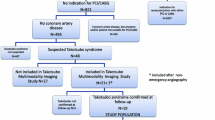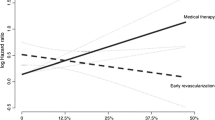Abstract
The detection of hibernating myocardium is important because revascularisation results in improved function and prognosis in patients with hibernation but not in those with non-viable myocardium. The primary aim of this study was to compare the diagnostic accuracy of four techniques with respect to hibernation in the same study population with 6–12 months of follow-up. Twenty-five males underwent rest-stress sestamibi and delayed (>18 h) thallium scintigraphy, high-dose dobutamine stress echocardiography and nitrogen-13 ammonia/fluorine-18 fluorodeoxyglucose (NH3/FDG) positron emission tomography (PET). The pre-operative ejection fraction was 36.2% (±7.3%). Follow-up was 8.1 (±2.8) months. Using postoperative improvement in wall motion on echocardiography as the gold standard, 6/34 dysfunctional vascular territories were hibernating. The mean uptake of all tracers was significantly higher in hibernating than in non-viable territories (P<0.05). Normal perfusion or mismatch on PET (FDG>NH3 uptake) and the pattern of response to dobutamine on echocardiography were also predictive of recovery (P<0.001 and P=0.02 respectively). Univariate logistic regression identified sestamibi, ammonia and FDG as independent predictors of hibernation. FDG-PET was, however, the only independent predictor using multivariate analysis. The nuclear techniques had high negative predictive values (NPV) of ≥95% but lower positive predictive values (PPV) of 45%–75% as compared with echocardiography, which had an NPV of 87% and a PPV of 100%. PET was the most powerful predictor of hibernation although the combination of a technique with a high PPV (echocardiography) and a high NPV (PET or sestamibi) may represent the optimal clinical choice.


Similar content being viewed by others
References
Rahimtoola SH. Concept and evaluation of hibernating myocardium. Annu Rev Med 1999; 50:75–86.
Allman KC, Shaw L, Hachamovitch R, Udelson JE. Myocardial viability testing and impact of revascularization on prognosis in patients with coronary artery disease and left ventricular dysfunction: a meta-analysis. J Am Coll Cardiol 2002; 39:1151–1158.
Bax JJ, Wijns W, Cornel JH, Visser FC, Boersma E, Fioretti PM. Accuracy of currently available techniques for prediction of functional recovery after revascularization in patients with left ventricular dysfunction due to chronic coronary artery disease: comparison of pooled data. J Am Coll Cardiol 1997; 30:1451–1460.
Vanoverschelde JL, Depre C, Gerber BL, Borgers M, Wijns W, Robert A, Dion R, Melin JA. Time course of functional recovery after coronary artery bypass graft surgery in patients with chronic left ventricular ischemic dysfunction. Am J Cardiol 2000; 85:1432–1439.
Qureshi U, Nagueh SF, Afridi I, Vaduganathan P, Blaustein A, Verani MS, Winters WLJ, Zoghbi WA. Dobutamine echocardiography and quantitative rest-redistribution201Tl tomography in myocardial hibernation. Relation of contractile reserve to 201Tl uptake and comparative prediction of recovery of function. Circulation 1997; 95:626–635.
Sciagra R, Bisi G, Santoro GM, Zerauschek F, Sestini S, Pedenovi P, Pappagallo R, Fazzini PF. Comparison of baseline-nitrate technetium-99m sestamibi with rest-redistribution thallium-201 tomography in detecting viable hibernating myocardium and predicting postrevascularization recovery. J Am Coll Cardiol 1997; 30:384–391.
Baer FM, Voth E, Deutsch HJ, Schneider CA, Horst M, de Vivie ER, Schicha H, Erdmann E, Sechtem U. Predictive value of low dose dobutamine transesophageal echocardiography and fluorine-18 fluorodeoxyglucose positron emission tomography for recovery of regional left ventricular function after successful revascularization. J Am Coll Cardiol 1996; 28:60–69.
Afridi I, Kleiman NS, Raizner AE, Zoghbi WA. Dobutamine echocardiography in myocardial hibernation. Optimal dose and accuracy in predicting recovery of ventricular function after coronary angioplasty. Circulation 1995; 91:663–670.
Cornel JH, Bax JJ, Elhendy A, Maat AP, Kimman GJ, Geleijnse ML, Rambaldi R, Boersma E, Fioretti PM. Biphasic response to dobutamine predicts improvement of global left ventricular function after surgical revascularization in patients with stable coronary artery disease: implications of time course of recovery on diagnostic accuracy. J Am Coll Cardiol 1998; 31:1002–1010.
Studholme C, Hill D, Hawkes D. Automated three-dimensional registration of magnetic resonance and positron emission tomography brain images by multiresolution optimisation of voxel similarity measures. Med Phys 1997; 24:25–35.
Nekolla SG, Miethaner C, Nguyen N, Ziegler SI, Schwaiger M. Reproducibility of polar map generation and assessment of defect severity and extent assessment in myocardial perfusion imaging using positron emission tomography. Eur J Nucl Med 1998; 25:1313–1321.
Gerber BL, Vanoverschelde JL, Bol A, Michel C, Labar D, Wijns W, Melin JA. Myocardial blood flow, glucose uptake, and recruitment of inotropic reserve in chronic left ventricular ischemic dysfunction. Implications for the pathophysiology of chronic myocardial hibernation. Circulation 1996; 94:651–659.
Bland D, Altmann DG. Statistical methods for assessing agreement between two methods of clinical measurement. Lancet 1986; 307–310.
Pagano D, Bonser RS, Townend JN, Ordoubadi F, Lorenzoni R, Camici PG. Predictive value of dobutamine echocardiography and positron emission tomography in identifying hibernating myocardium in patients with postischaemic heart failure. Heart 1998; 79:281–288.
Vanoverschelde JL, D’Hondt AM, Marwick T, Gerber BL, De Kock M, Dion R, Wijns W, Melin JA. Head-to-head comparison of exercise-redistribution-reinjection thallium single-photon emission computed tomography and low dose dobutamine echocardiography for prediction of reversibility of chronic left ventricular ischemic dysfunction. J Am Coll Cardiol 1996; 28:432–442.
Samady H, Elefteriades J, Abbott B, Mattera J, McPherson C, Wackers FJ. Failure to improve left ventricular function after coronary revascularization for ischemic cardiomyopathy is not associated with worse outcome. Circulation 1999; 100:1298–1304.
Pagano D, Townend JN, Parums DV, Bonser RS, Camici PG. Hibernating myocardium: morphological correlates of inotropic stimulation and glucose uptake. Heart 2000; 83:456–461.
Schelbert HR. Measurements of myocardial metabolism in patients with ischaemic heart disease. Am J Cardiol 1998; 82:61K–67K.
Sciagra R, Leoncini M, Marcucci G, Dabizzi R, Pupi A. Technetium-99m sestamibi imaging to predict left ventricular ejection fraction outcome after revascularisation in patients with chronic coronary artery disease and left ventricular dysfunction: comparison between baseline and nitrate-enhanced imaging. Eur J Nucl Med 2001; 28:680–687.
Depre C, Vanoverschelde JL, Melin JA, Borgers M, Bol A, Ausma J, Dion R, Wijns W. Structural and metabolic correlates of the reversibility of chronic left ventricular ischemic dysfunction in humans. Am J Physiol 1995; 268: H1265–H1275.
Beller G. Ischemic cardiomyopathy: How to identify appropriate candidates for revascularisation? ACC Curr J Rev 2001; 45–48.
Kiat H, Berman DS, Maddahi J, De Yang L, Van Train K, Rozanski A, Friedman J. Late reversibility of tomographic myocardial thallium-201 defects: an accurate marker of myocardial viability. J Am Coll Cardiol 1988; 12:1456–1463.
Yang LD, Berman DS, Kiat H, Resser KJ, Friedman JD, Rozanski A, Maddahi J. The frequency of late reversibility in SPECT thallium-201 stress-redistribution studies. J Am Coll Cardiol 1990; 15:334–340.
Afridi I, Qureshi U, Kopelen HA, Winters WL, Zoghbi WA. Serial changes in response of hibernating myocardium to inotropic stimulation after revascularization: a dobutamine echocardiographic study. J Am Coll Cardiol 1997; 30:1233–1240.
Kim R, Wu E, Rafael A, Chen E, Parker M, Simonetti O, Klocke FJ, Bonow RO, Judd R. The use of contrast-enhanced magnetic resonance imaging to identify reversible myocardial dysfunction. N Engl J Med 2000; 343:1445–1453.
Acknowledgements
Dr. Barrington was kindly supported as Clinical Fellow by the Private Patients Plan Charitable Trust.
Author information
Authors and Affiliations
Corresponding author
Rights and permissions
About this article
Cite this article
Barrington, S.F., Chambers, J., Hallett, W.A. et al. Comparison of sestamibi, thallium, echocardiography and PET for the detection of hibernating myocardium. Eur J Nucl Med Mol Imaging 31, 355–361 (2004). https://doi.org/10.1007/s00259-003-1369-9
Received:
Accepted:
Published:
Issue Date:
DOI: https://doi.org/10.1007/s00259-003-1369-9




